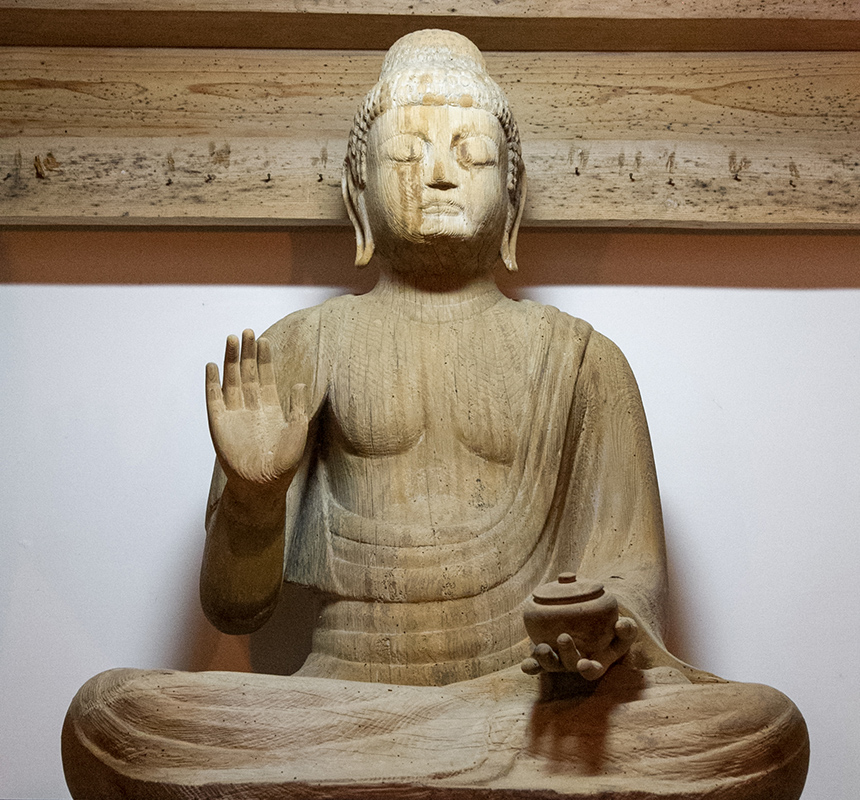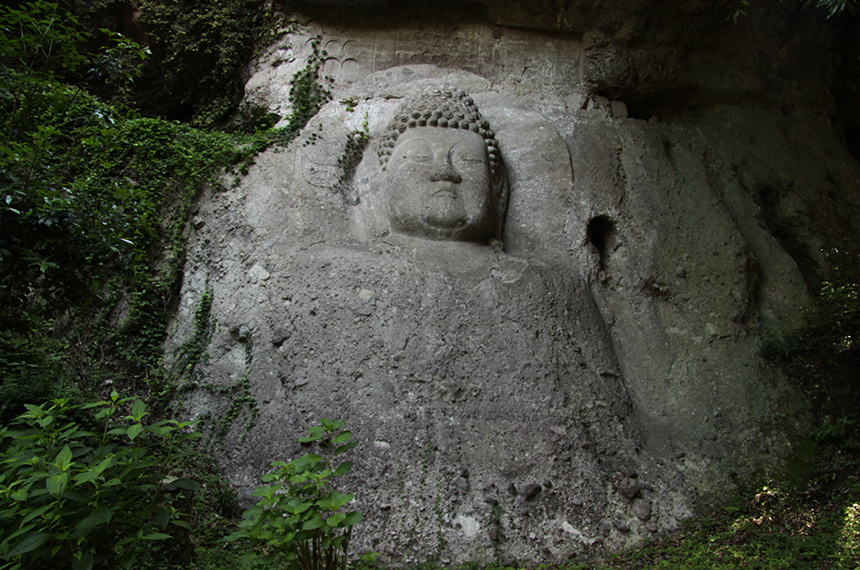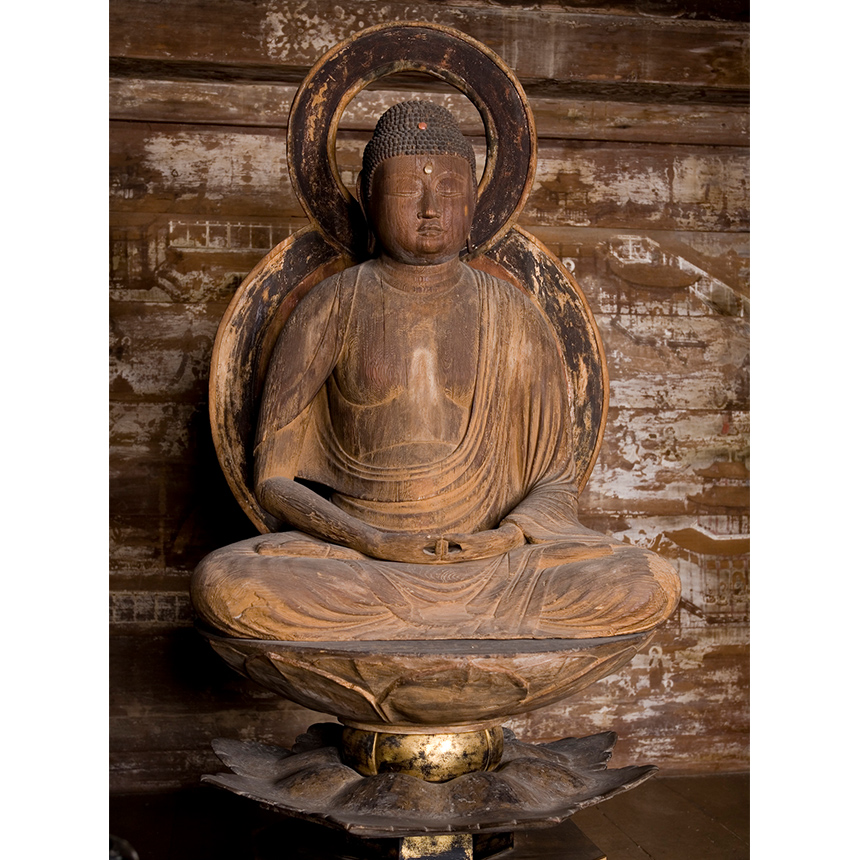Deities of Kunisaki and Beyond

Shaka Nyorai
Shakyamuni
Shakyamuni is the historical Buddha ‘of our times’. He was born into the noble Indian clan of the Shakyas. Shakyamuni literally means “sage of the Shakyas”.
As the founding master of Buddhism and the earliest expounder of the Dharma (the Good Law) the Buddha Shakyamuni Gautama is venerated above all by those who profess his teaching. He is venerated by all Buddhist sects, except the Shin-Jodo Shinshu sect that is exclusively devoted to one of Shakyamuni’s forms, Amidha Buddha.
Guatama, however, is never really considered as a deity. He is, instead, regarded as the most perfect of holy men, as an ideal of perfect Buddhist virtues. Statues of this period of his life are uncommon. At first it seems followers were reluctant to try and depict the Buddha in human form. Instead they revered things associated with him such as reliquary towers or stupas; the Bo tree under which he attained enlightenment; the Dharma Wheel (Dharmacakra) associated with his teaching; and his footprint engraved in stone. Indian Buddhists generally preferred to represent his aspect as a Bodhisattva. Images, though, began to appear around the First Century and by the Gupta Period (4th ~ 6th Centuries) the image of the Buddha became firmly fixed. The lines are serene, the face full and the ear lobes are extended. The robe covers either one or both shoulders and he is represented upright, feet slightly apart, in a frontal posture with hands in Abhaya and Varada mudras; or seated in Padmasana, with the soles of the feet visible, or making the gesture of turning the Dharmacakra. In Tibet, China, Korea and Japan these are very similar in style to those of India.
It appears that the introduction to Japan of the first image representing the historical Buddha took place in 538 A.D., when a bronze statue was sent to the Yamato Court in Asuka by the King of Kudara in Korea. In Japan, the Buddha is not always venerated alone but in a group with other personages, Amidha Buddha and Miroku (Maitreya), the future Buddha. The three together remind the faithful that the Law exists both for humans here on Earth and for those of the world beyond, and that it will continue to be so in the future.
The Buddha is honoured on many occasions, including the anniversary of his birth (Kanbutsu-e in Japan) on 8th April. The Japanese accord to him a lucky or unlucky influence on particular days of the calendar.
Yakushi Nyorai
Bhaishajyaguru – The Medicine Buddha

Apart from the historical Buddha, two other forms of Buddha, Amitabha and Yakushi Nyorai, enjoyed great popularity in Japan.
Yakushi Nyorai is invoked to obtain something. He is the master of remedies, the ‘sage and knowing doctor of the sufferings of this world’. In Japan, his cult found great favour until the 12th Century. However, to this day Yakushi is still venerated by many Japanese, finding a popularity that extends beyond the dogma of the various sects. The Japanese sometimes grant him such importance that he can be found placed at the centre of the Buddhist pantheon in the place of Dainichi Nyorai.
Like every Jina (see below), he has a territory for preaching. This area, which is in the east on the side of the rising sun, predestined him to become an essentially Japanese Buddha. Perhaps because of this, Yakushi was one of the first deities to be venerated in Japan. The famous temple Horyu-ji in Nara was built in 587 AD by Shotoku Taishi to accommodate a large bronze statue of him in order to secure a cure for the emperor, Yomei. In 680 AD, Yakushi-ji was built in Nara on the orders of emperor Tenmu to ensure the recovery of his ailing consort, later to be the empress Jito. Yakushi is the major object of worship at the great Nara temples of Kofuku-ji, Toshodai-ji and also the Tendai temple Enryaku-ji on Mt. Hiei, near Kyoto.
The attributes of Yakushi include watching over the health of the people; protecting them against epidemics, diseases, dangers to families and pregnant women;
of preserving those on sea voyages from danger, and curing infertility. He is believed to grant longevity and cure eye complaints.
The earliest images of Yakushi are identical with representations of Shakyamuni. Later images show him holding either a sacred jewel or medicine container in his left hand. Yakushi has seven emanation Buddha, which he assumes during functions as a healer, are depicted on an aureole behind his head. These are usually represented above Yakushi.
Gochi Nyorai, The Five Jinas
Tathagata
The five Jinas are also known as the five Tathgatas, or as the five Great Buddhas of Wisdom. Jina means ‘conqueror’ and refers in a religious context to one who has conquered spiritual knowledge and overcome the cycle of rebirth and suffering. Each of the five Jinas is three entities in one: the historical Buddha, his mystical projection, and his acting emanation. The five Jinas also correspond to the five steps on the road to salvation.
Dainichi Nyorai
Vairocana/Mahavairocana

In Japan, Dainichi Nyorai is the Great Solar Buddha of light and truth. He is the sun, like the Shinto goddess Amaterasu Omikami. He is the spiritualisation of Gautama Buddha in Buddhist Law and in all matters remains pragmatic. He is attributed the colour white because it is the synthesis of all other colours and symbolises all that is ‘spotless’ (Muku). He is the personification of the Absolute. He is considered first among the Jinas, the other four are considered as manifestations of him. He is also considered the unifier of the two parts of the world, the two mandalas.
Dainichi is particularly popular among followers of the esoteric Shingon and Tendai Sects. Esoteric teachings advocate training and discipline to establish contact with the cosmic life and to enable us to attain Buddhahood in the present body. Dainichi represents the cosmic life that surrounds us. Everything in the cosmos is a manifestation of Dainichi.
In appearance Dainichi looks like a Bosatsu. His elaborately arranged hair is surmounted by a crown and he wears richly jewelled ornaments. He sometimes holds the Wisdom mudra with hands held up to the chest and the fingers of one hand wrapped around one finger of the other hand.
Amida Nyorai
Amitabha Buddha

Amida Nyorai is the fourth Jina. His preaching territory is set in the west and symbolises the setting sun as well as life in the beyond. His western paradise is the Pure Land (Japanese: Gokuraku Jodo), the paradise in which all mortals are reborn. Here souls, rid of all impurities and pure of all desire, go to the call of Amidha. In the beyond he welcomes and consoles; out of compassion he delivers creatures from their suffering and welcomes them to his Pure Land.
Like other Jinas, Amidha is also a personification of one of the episodes of the life of the historical Buddha. Amidha undertook to save all beings, irrespective of who they were. This role of saviour together with the simplicity of the Pure Land sects doctrine earned him great popularity in Tibet, China and Japan. In Japan, the Jodo-Shu (Pure Land) sect made him its principal deity and Jodo-Shinshu (True Pure Land) sect its only deity. Shinran (1173 ~ 1212), the founder of Jodo-Shinsu, said that Amitabha had already bestowed salvation on us. All we need to do is invoke his name in gratitude.
The appeal to the masses of a simple doctrine founded on faith led to a growing popularity of the Amidha cults and transformed Japanese Buddhism by disseminating fragments of doctrine to all people. More than in other countries this profoundly altered the attitudes of the people. Before the 9th Century, Buddhist deities had been seen as foreign, aristocratic entities, whom it was wise to avoid offending and who were worthy of reverence. However, direct relations were difficult as they were separated by a mass of religious text written in Chinese and by priests who were not concerned to make the texts more accessible.
Early Buddhism had associated its deities with the indigenous shinto kami of Japan. Amidha was identified with the most important kami, Amaterasu Omikami. Amaterasu is considered to be the ancestor of the imperial family and is venerated at Ise Jingu shrine. Amidha was also identified with Hachiman, a kami of war and a kami at Mt. Hiei, near Kyoto. Many temples were built to Amidha throughout Japan and, as symbols on earth of Pure Land (Gokuraku) were richly decorated. Sumptuous festivals were celebrated in the hope of equalling the enchantment in peoples’ minds of the Pure Land. These temples became the centre of social life.
The worship of Amitabha is still widespread to this day in Japan although it has largely disappeared in other countries. The recitation of his name, ‘Nembutsu, Namu Amidha Butsu’ (Homage to Amidha Buddha) is perfomed by adherents of the Jodo-Shu, Jodo-Shinshu and, sometimes, by the Tendai sects. However, it is little used by Zen sects and rejected by the Nichiren sect.
Amidha is usually represented in meditation in the full lotus position with both legs crossed. His hands form meditation mudras. In very old representations Amitabha hands are in a preaching mudra. Amitabha can also be found with his acolytes, the Bodisattvas Kannon and Seishi Bosatsu (Mahasthamaprata).




